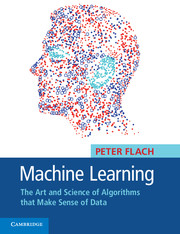Book contents
- Frontmatter
- Contents
- Preface
- Prologue: A machine learning sampler
- 1 The ingredients of machine learning
- 2 Binary classification and related tasks
- 3 Beyond binary classification
- 4 Concept learning
- 5 Tree models
- 6 Rule models
- 7 Linear models
- 8 Distance-based models
- 9 Probabilistic models
- 10 Features
- 11 Model ensembles
- 12 Machine learning experiments
- Epilogue: Where to go from here
- Important points to remember
- References
- Index
1 - The ingredients of machine learning
Published online by Cambridge University Press: 05 November 2012
- Frontmatter
- Contents
- Preface
- Prologue: A machine learning sampler
- 1 The ingredients of machine learning
- 2 Binary classification and related tasks
- 3 Beyond binary classification
- 4 Concept learning
- 5 Tree models
- 6 Rule models
- 7 Linear models
- 8 Distance-based models
- 9 Probabilistic models
- 10 Features
- 11 Model ensembles
- 12 Machine learning experiments
- Epilogue: Where to go from here
- Important points to remember
- References
- Index
Summary
MACHINE LEARNING IS ALL ABOUT using the right features to build the right models that achieve the right tasks – this is the slogan, visualised in Figure 3 on p.11, with which we ended the Prologue. In essence, features define a ‘language’ in which we describe the relevant objects in our domain, be they e-mails or complex organic molecules. We should not normally have to go back to the domain objects themselves once we have a suitable feature representation, which is why features play such an important role in machine learning. We will take a closer look at them in Section 1.3. A task is an abstract representation of a problem we want to solve regarding those domain objects: the most common form of these is classifying them into two or more classes, but we shall encounter other tasks throughout the book. Many of these tasks can be represented as a mapping from data points to outputs. This mapping or model is itself produced as the output of a machine learning algorithm applied to training data; there is a wide variety of models to choose from, as we shall see in Section 1.2.
We start this chapter by discussing tasks, the problems that can be solved with machine learning. No matter what variety of machine learning models you may encounter, you will find that they are designed to solve one of only a small number of tasks and use only a few different types of features.
- Type
- Chapter
- Information
- Machine LearningThe Art and Science of Algorithms that Make Sense of Data, pp. 13 - 48Publisher: Cambridge University PressPrint publication year: 2012
- 4
- Cited by

